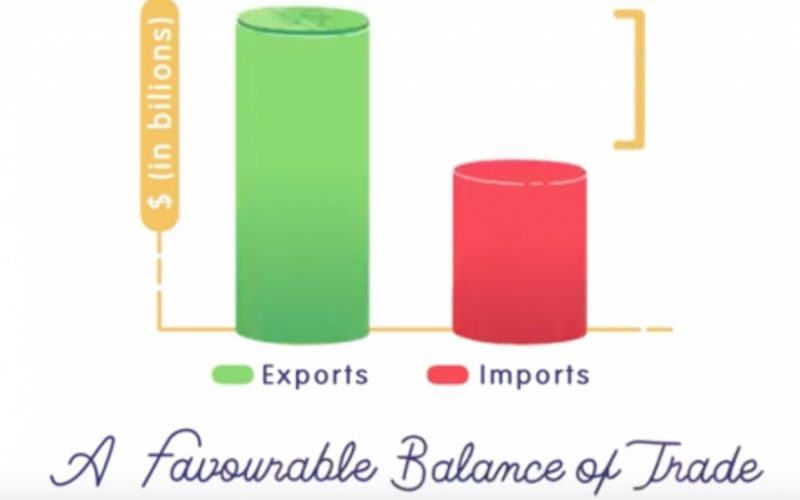A favourable balance of trade occurs when the exportation value of a country is more than what it imports. It is referred to as favourable because it’s a healthy economic situation that exists as a result of a surplus in the trade balance of a given country. Unfortunately, some countries have an unfavourable trade balance, but this does not imply that their economy is unhealthy. Simply put, what they import is of a higher demand in their country.
In this article, we will discuss a favourable trade balance and when an unfavourable trade balance exists or occurs in the trade value of a particular country. Let’s go
What is Favourable Trade Balance?
The trade balance is also known as the international trade balance, the commercial balance, or the net exports. It’s an economic metric calculated by deducting the total amount of imported goods from the total amount of exported goods. Thus: X-M=TB, Where
X means Exports
M means Imports
And TB means Trade balance.
This balance explains where the country stands in terms of trade and commercial relations with other countries. If the trade balance is favourable, it means that the country exports more than it imports, and if it is unfavourable, it means the opposite. However, a favourable trade balance is not always a good thing for a country as unfavourable doesn’t always mean a bad thing either
Exports are goods or services produced in the United States and sold to a foreigner. This includes a pair of jeans mailed to a friend in another country. It could also be signage transferred from a corporate headquarters to a foreign office. As long as a foreigner pays for it, it is considered an export.
Imports, on the other hand, are goods and services purchased by residents of a country but manufactured in another country. Souvenirs purchased by tourists travelling abroad are among. Travel services, such as transportation, hotels, and meals, are also imported. It makes no difference whether the company producing the goods or services is domestic or foreign. It is an import if it was purchased or manufactured in another country.
Favourable Balance of Trade Occurs in a Country
A trade surplus or favourable trade balance occurs in a country when it exports greater value than it imports, conversely, when it imports more than it exports, there exists a trade deficit or an unfavourable trade balance.
Many countries pursue trade policies that promote a trade surplus. These countries prefer to sell more goods and receive more capital for their citizens, believing that this will result in a higher standard of living and a competitive advantage for domestic firms. This is true for some, especially in the short term.
Some countries resort to trade protectionism to maintain a trade surplus. Tariffs, quotas, and subsidies on imports protects domestic industries. Other countries quickly retaliate with retaliatory, protectionist measures, resulting in a trade war. This invariably leads to higher consumer prices, decreased international trade, and worsening economic conditions for all nations.
Example
Assume Argentina is primarily a meat producer, with meat accounting for more than half of the country’s exports. The country is currently receiving meat from other countries, which has drawn gasps among domestic industry players. Under pressure from lobbying groups, the government decided to enact protectionist measures to reduce the amount of imported meat entering the country.
This would increase domestic consumption because imported meat accounted for 20% of domestic consumption, reducing meat producers’ ability to export significantly. What had previously been a favourable trade balance in the country (for the meat production industry) became an unfavourable balance, causing negative effects on the country’s economic value.
What is Unfavourable Balance of Trade
A country has a favourable trade balance or trade surplus when its export value exceed its imports. On the other hand, an unfavourable trade balance or deficit occurs when exportation value is less than what a country imports. A surplus appears to be preferable to a deficit. This, however, is an overly simplistic assumption. A trade deficit is not always a bad thing, as it can indicate a healthy economy. Furthermore, when combined with prudent investment decisions, a deficit can lead to stronger future economic growth.
Conversely, a trade deficit can be unfavourable for a country, particularly one whose economy is heavily reliant on raw material exports. In general, this type of country imports a lot of consumer goods. As a result, its domestic businesses lack the experience required to produce value-added products. Rather, its economy is becoming increasingly reliant on volatile global commodity prices.
According to 2019 statistics, Germany had the largest trade surplus, followed by Japan and China, while the US had the largest trade deficit, edging out the UK and Brazil despite the ongoing trade war with China.
Determining Factors of a Country’s Trade Balance.
Certain factors determine whether the balance of trade is favourable or unfavourable in a given country. Labor, land, and capital are examples of these factors.
The labour factor refers to the characteristics of a country’s workforce. Land refers to the available natural resources, such as timber or oil whereas infrastructure and production capacity are examples of capital. Of course, the productivity of the above-mentioned factors is critical.
Let’s say for instance two countries have equal labour and land endowments. One country has a skilled labour force and highly productive land resources, while the other has unskilled labour and low-productivity resources.
Consequently, the skilled labour force would produce more per person than the unskilled labour force, which affects the areas where each has a comparative advantage. The country with skilled labour may specialize in complex electronics, whereas the country with unskilled labour may specialize in basic manufacturing.
Similarly, efficient use of natural resources can mean extracting more or less value from a similar initial endowment.
Trade limitations
Trade barriers also have an impact on a country’s export-import balance. Policies that restrict imports or subsidize exports affect the relative prices of those goods, making them more or less appealing to import or export. Agricultural subsidies, for example, could lower farming costs, encouraging more export production. Import quotas raise the prices of imported goods, reducing demand.
Countries with high import tariffs and duties may run larger trade deficits than countries with open trade policies. This is because trade fences may keep them from accessing export markets. There is also a non-tariff trade policy as a form of trade limitation. However, investment in certain areas is critical to reducing these constraints. Infrastructure investments, for example, can broaden a country’s capital base while lowering the cost of getting goods to market.
Other factors that determine when favourable trade balance occurs or exists in a country and it’s importation value includes
- The availability of sufficient foreign currency to pay for imports;
- Prices of domestically produced goods (influenced by the responsiveness of supply)
- The price and supply of raw materials, intermediate goods, and other inputs; and
- Changes in currency exchange rates
When there is a Favourable balance of trade formula?
Consequently, the following equation can be used to determine the balance of trade, or BOT: Export value minus import value is the balance of trade (BOT). where BOT stands for the balance of trade. The value of exports is the cost of items that are shipped outside the nation and sold to customers in other nations.
What is Unfavourable balance of trade?
The balance of trade is defined as the difference between a country’s imports and exports within a particular time period. A trade balance that is unfavorable occurs when imports exceed exports.
Which is positive balance of trade for a country?
If exports are greater than imports, the trade balance of that nation is positive (and hence shows a surplus). If imports are greater than exports, the trade balance of a nation is in the negative, or shows a deficit.
What is Unfavourable and Favourable?
The discrepancy between budgeted and actual amounts is known as a variance in the accounting world. Favorable variations are defined as increased revenues and decreased costs. Unfavorable variations are defined as a decrease in revenues and an increase in expenses.
Is a negative trade balance good?
Although extremely big deficits can have a detrimental effect on the economy, trade deficits are neither fundamentally fully beneficial nor harmful. A robust economy may indicate a trade deficit, which under certain circumstances may result in future economic growth for the deficit-running nation.
Is positive terms of trade good?
Thus, a higher TOT may be advantageous as fewer exports are required to fund a given level of imports. When the TOT rises, it may also have a favorable effect on domestic cost-push inflation because the rise is a sign that import costs are becoming more competitive with export prices.
Summary
To summarize, it is not always possible for every country to have or run a trade surplus. As a result, developing countries should always focus on how to produce home or domestic products at a lower cost so that they do not have to import goods from foreign exporting countries, which can lead to cash outflows that are not beneficial to our developing countries.
In addition to practising import substitution, they should also concentrate on producing specific goods and services that distinguish them in the global economy so that foreign countries export from the domestic economy and the economy grows.
Related Articles
- National Income Accounting: Definitive Guide for Beginners’ with Examples
- Mexican Beer Brands: 13 Top Best Mexican Beer Brands You Need To Know
- Balance of Trade (BOT): Definition, Components, and Calculations
- Can Undervalued Currency Boost an Economy?
- Balance Of Trade: Explained!!! Meaning, Importance, Formula
Frequently Asked Questions
What is favourable trade terms?
If the prices of a country’s exports rise relative to the prices of its imports, one says that its terms of trade have moved in a favourable direction, because, in effect, it now receives more imports for each unit of goods exported.
How does the balance of trade affect the economy?
The balance of trade impacts currency exchange rates as supply and demand can lead to an appreciation or depreciation of currencies. … A country that imports more than it exports will have less demand for its currency
How is the favorable balance of trade an indicator of economic development of a country?
The favourable balance of trade indicates the exports are greater than imports and it is known as trade surplus. The trade surplus has a positive impact on the development of the country and the positive impacts are: It increases the revenue of the economy as a whole because exports are revenue for the country.
Which country has a favourable balance of trade?
In 2020, China was the country with the highest trade surplus with approximately 535.37 billion U.S. dollars. Typically a trade surplus indicates a sign of economic success and a trade deficit indicates an economic weakness
What is meant by favourable balance of trade?
The term “favourable balance of trade” is used by American economists, almost without exception, to mean an excess of commodity exports over commodity imports, and, in turn, an “unfavourable balance of trade” means an excess of commodity imports over commodity exports






